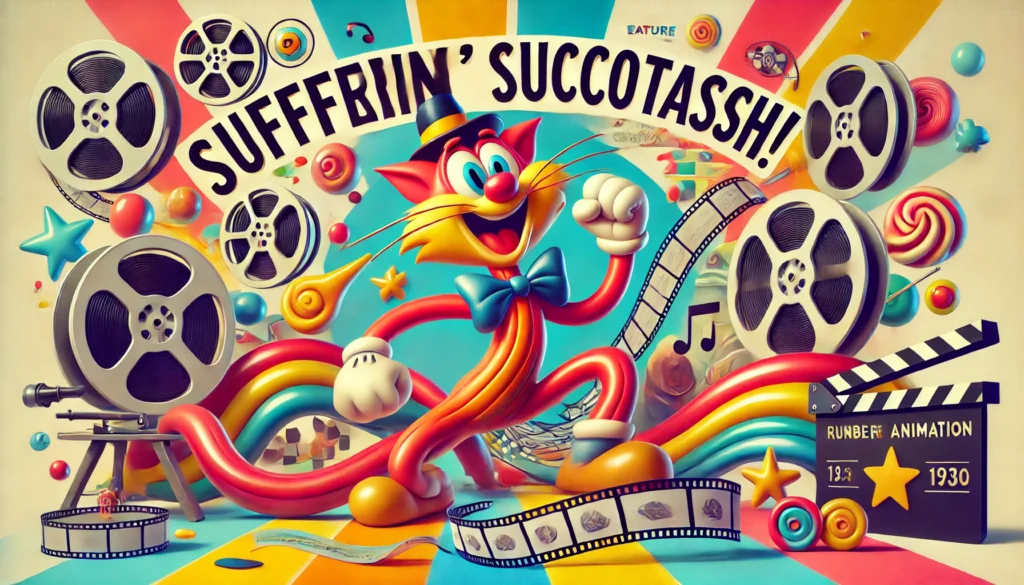
The Origins of “Sufferin’ Succotash”
“Sufferin’ Succotash” was first popularized by Sylvester the Cat, a character who debuted in the 1940s. The phrase is a playful minced oath, a mild substitute for “Suffering Savior,” avoiding the more overtly religious connotations of its root phrase.
Sylvester, known for his lisping speech, turned the phrase into a comedic hallmark. His exclamation became synonymous with frustration, disbelief, or surprise, often directed at his arch-nemesis, Tweety Bird. This catchphrase cemented itself in the hearts of audiences worldwide, transcending generations.
What is “Rubrehose”?
“Rubrehose” refers to a distinctive animation style prominent during the early 20th century, particularly in the 1920s and 1930s. Named after the exaggerated rubbery and stretchy movements of characters’ limbs, this style was a hallmark of the early days of animation. Characters like Felix the Cat, Mickey Mouse, and Betty Boop were pioneers of the “rubber hose” animation technique.
This technique emerged due to the technical limitations of early animation, where smooth movements were difficult to achieve with hand-drawn frames. Animators adopted this stretchy, elastic aesthetic as a practical solution, creating characters whose limbs could bend and stretch like hoses.
The Fusion of “Sufferin’ Succotash” and “Rubrehose”
The phrase “Sufferin Succotash Rubrehose” is a delightful fusion of Sylvester’s iconic exclamation with the vintage charm of rubber hose animation. While it may not have been a term used during the golden age of animation, its emergence in modern discussions is a testament to how internet culture loves to blend nostalgia with creativity.
The term often appears in discussions about animation history or as a playful nod to the enduring influence of classic cartoons on contemporary media.
Cultural Significance of “Rubrehose” Animation
Rubber hose animation holds a special place in the history of entertainment. It represents the innovation and creativity of early animators, who overcame technological barriers to bring stories to life.
Simplicity in Design
Rubber hose characters were simplistic yet dynamic. Their designs prioritized exaggerated expressions and movements over intricate details, making them instantly recognizable and endearing.
Universality in Appeal
These characters resonated with audiences worldwide, thanks to their expressive body language and universal themes of humor, mischief, and adventure.
Influence on Modern Media
The rubber hose style has seen a resurgence in modern animation, with shows like Cuphead embracing its aesthetics. This revival celebrates the whimsical, bouncy energy that rubber hose animation brings to storytelling.
“Sufferin’ Succotash Rubrehose” in Internet Culture
In the digital age, phrases like “Sufferin Succotash Rubrehose” gain traction as memes, hashtags, or witty comments in forums and social media. This phenomenon reflects the blending of nostalgia and innovation in how we consume and create content.
Meme Culture
The phrase has been adapted into memes that juxtapose Sylvester’s frustrated catchphrase with exaggerated rubber hose animations, creating humorous and absurd scenarios.
Tribute to Animation
Artists and fans often use the term to pay homage to both Sylvester the Cat and the rubber hose style, celebrating their influence on the evolution of animation.
Linguistic Creativity
Combining “Sufferin’ Succotash” with “Rubrehose” exemplifies how language evolves through playful experimentation. Such combinations keep cultural icons relevant to new generations.
The Legacy of Sylvester and Rubber Hose Animation
The enduring popularity of Sylvester the Cat and the rubber hose animation style speaks volumes about their cultural impact.
Sylvester’s Timeless Appeal
Sylvester’s relatable personality and comedic antics ensure he remains a beloved figure in animation history. His lisping catchphrase, “Sufferin’ Succotash,” continues to evoke laughter and nostalgia.
Rubber Hose’s Influence on Modern Animation
From vintage cartoons to modern reimaginings like Cuphead, rubber hose animation continues to inspire animators. Its whimsical aesthetic and limitless possibilities make it a timeless storytelling tool.
Bridging Generations
The fusion of classic elements like “Sufferin Succotash” with modern cultural trends ensures that these icons remain relevant, connecting older fans with younger audiences.
The Artistic Revival of Rubber Hose Animation
The rubber hose style has experienced a renaissance in recent years, thanks to a renewed interest in vintage aesthetics. This revival is evident in various forms of media, from video games to animated series.
Video Games: The Cuphead Phenomenon
The 2017 game Cuphead brought rubber hose animation back into the limelight. Its hand-drawn, 1930s-inspired visuals captivated players and critics alike, proving the enduring appeal of this style.
Indie Animation Projects
Many independent animators have embraced the rubber hose style, creating short films and web series that pay homage to its playful and imaginative spirit.
Merchandise and Branding
Rubber hose-inspired designs have found their way into merchandise, fashion, and branding, appealing to fans of vintage aesthetics.
Why “Sufferin Succotash Rubrehose” Matters Today
In an era dominated by digital innovation, the phrase “Sufferin Succotash Rubrehose” reminds us of the importance of preserving and celebrating our cultural heritage.
Nostalgia and Connection
For many, phrases like “Sufferin Succotash” evoke fond memories of childhood, creating a sense of connection to simpler times.
Creative Fusion
The blending of classic catchphrases with animation history showcases the limitless possibilities of creative expression.
Keeping History Alive
By revisiting and reimagining icons like Sylvester the Cat and rubber hose animation, we ensure that their legacy continues to inspire future generations.
The Future of Rubber Hose Aesthetics and Iconic Catchphrases
As technology evolves, the way we create and consume animation will continue to change. However, the charm of rubber hose animation and the humor of Sylvester’s catchphrases will always have a place in our hearts.
Innovations in Animation
Advancements in animation technology allow artists to recreate the rubber hose style with greater precision and creativity, ensuring its continued relevance.
Cultural Preservation
Efforts to archive and restore classic cartoons help preserve the history of animation for future audiences.
Inspiring New Generations
The playful spirit of “Sufferin Succotash” and the boundless imagination of rubber hose animation encourage young artists to explore and experiment with their creative visions.
Conclusion
The phrase “Sufferin Succotash Rubrehose” is more than just a playful blend of words; it represents a bridge between the past and the present. By combining Sylvester the Cat’s iconic catchphrase with the whimsical charm of rubber hose animation, it celebrates the enduring legacy of classic cartoons and their influence on modern culture.
Whether you’re a fan of vintage animation, a lover of linguistic creativity, or simply someone who enjoys a good laugh, the story behind “Sufferin Succotash Rubrehose” offers something for everyone. It’s a testament to the power of nostalgia, innovation, and the timeless appeal of animated storytelling.
